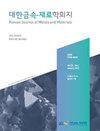激光表面熔化抑制247LC定向凝固高温合金凝固裂纹的方法及外延生长行为
IF 1.4
4区 材料科学
Q4 MATERIALS SCIENCE, MULTIDISCIPLINARY
引用次数: 1
摘要
在本研究中,从根本上和冶金上研究了定向凝固247LC高温合金的凝固裂纹和外延生长行为与高速激光表面熔化之间的关系,为下一代燃气轮机叶片开发了一种成功的焊接工艺。在典型的激光表面熔化条件下(扫描速度:50mm/s,热输入:40J/mm),会出现严重的凝固开裂现象。凝固开裂的关键冶金因素已被确定为凝固偏析辅助的凝固晶界和随机形成的多晶熔化区微观结构中的管道扩散行为。此外,在极低的热输入和高速激光束扫描条件下(扫描速度:1000mm/s,热输入:2J/mm),利用单模光纤激光器的特性,可以在相对高能的束密度(65J/mm2)下在单向固化晶粒内获得有效的表面熔化区。结果表明,激光熔化区成功地实现了99.9%的外延生长。由于在激光表面熔化区内具有优异的外延生长率和快速凝固现象,可以抑制凝固晶界的形成和凝固偏析辅助的管道扩散行为。最后,可以实现无凝固裂纹的激光熔化区。本文章由计算机程序翻译,如有差异,请以英文原文为准。
Method of Suppressing Solidification Cracking by Laser Surface Melting and Epitaxial Growth Behavior for Directionally Solidified 247LC Superalloy
In this study, the relationship between solidification cracking and epitaxial growth behavior with the high-speed laser surface melting of a directionally solidified 247LC superalloys was fundamentally and metallurgically investigated, to develop a successful welding procedure for the next generation of gas turbine blades. Under typical laser surface melting conditions (scan speed: 50 mm/s, heat input: 40 J/mm), severe solidification cracking phenomena occurs. The key metallurgical factors of solidification cracking have been identified as solidification segregation-assisted pipeline diffusion behavior at the solidification grain boundary, and in the randomly formed polycrystalline melting zone microstructure. In addition, under extremely low heat input and high-speed laser beam scan conditions (scan speed: 1000 mm/s, heat input: 2 J/mm), an effective surface melting zone can be obtained within a single directionally solidified grain under a relatively high-energy beam density (65 J/mm2) using the characteristics of single-mode fiber lasers. Results reveal that the laser melting zone successfully shows a 99.9% epitaxial growth achievement ratio. Because of the superior epitaxial growth ratio within the laser surface melting zone, and the rapid solidification phenomena, formation of a solidification grain boundary and solidification segregation-assisted pipeline diffusion behavior can be suppressed. Finally, a solidification crack-free laser melting zone can thus be achieved.
求助全文
通过发布文献求助,成功后即可免费获取论文全文。
去求助
来源期刊

Korean Journal of Metals and Materials
MATERIALS SCIENCE, MULTIDISCIPLINARY-METALLURGY & METALLURGICAL ENGINEERING
CiteScore
1.80
自引率
58.30%
发文量
100
审稿时长
4-8 weeks
期刊介绍:
The Korean Journal of Metals and Materials is a representative Korean-language journal of the Korean Institute of Metals and Materials (KIM); it publishes domestic and foreign academic papers related to metals and materials, in abroad range of fields from metals and materials to nano-materials, biomaterials, functional materials, energy materials, and new materials, and its official ISO designation is Korean J. Met. Mater.
 求助内容:
求助内容: 应助结果提醒方式:
应助结果提醒方式:


